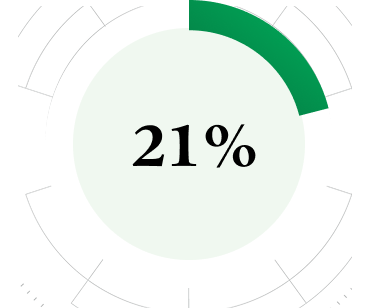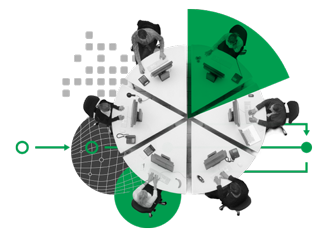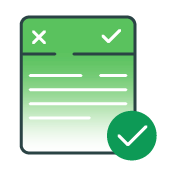![Employee Engagement PP > Top Card > 2025-08 [UPDATE]](https://imagekit.gallup.com/fusion/tr:n-emd_tmpl_dlp_bg_lg/WORKPLACEV9CMS/22e22249-7b2b-4451-86f5-b247f74459ff.jpg)
What Is Employee Engagement, and How Do You Improve It?
Employee engagement is the emotional connection and commitment employees have to their work and organization — it goes beyond employee satisfaction. Improving employee engagement requires a research-backed strategy that equips leaders to create the conditions under which people and business performance thrive.
What Is Employee Engagement?
What Is Employee Engagement?
Gallup defines employee engagement as the involvement and enthusiasm of employees in their work and workplace. Highly engaged employees are emotionally connected and committed to their work, and they perform better.

Engaged employees are more likely to:
-
take initiative and go beyond what's expected of them
-
stay with their company longer
-
deliver better customer outcomes
-
collaborate effectively with others
-
show resilience under stress or change
Measuring employee engagement offers leaders insight into the employee experience, showing them whether employees are deeply invested in their work or just going through the motions.
Measurement reveals whether an organization's team-building efforts and HR strategies are driving results or need improvement. Using Gallup's approach to employee engagement, leaders can strengthen employees' connection to their work, build a more resilient culture and prevent burnout before it takes hold.
Why Is Employee Engagement Important?
Why Is Employee Engagement Important?
Employee engagement is a performance strategy that distinguishes high-performing cultures from struggling ones. Gallup's workplace engagement data show that engaged employees drive stronger business outcomes across every industry, regardless of company size or economic conditions.

Engaging employees leads to:
-
higher productivity and profitability
-
lower absenteeism and turnover
-
fewer safety incidents and quality defects
-
stronger customer loyalty
These outcomes are based on decades of research across industries and organizations worldwide. When comparing the most engaged teams to the least engaged, Gallup research reveals the clear benefits of employee engagement:
What highly engaged employees achieve more of:
10% higher customer loyalty/engagement
14% higher productivity (production records and evaluations)
18% higher productivity (sales)
23% higher profitability
70% higher wellbeing (net thriving employees)
22% higher organizational citizenship (participation)
What highly engaged employees achieve less of:
78% less absenteeism
21% less turnover for high-turnover organizations
51% less turnover for low-turnover organizations
28% less shrinkage (theft)
63% fewer safety incidents (accidents)
32% fewer quality defects
*The above figures are median percent differences across companies in Gallup's database. High-turnover organizations are those with more than 40% annualized turnover. Low-turnover organizations are those with 40% or lower annualized turnover.
Employees make decisions and take actions every day that can affect both the workforce and organizational effectiveness. The way a company treats employees and how employees treat one another can positively affect their actions or can place an organization at risk.

But only 21% of employees worldwide and 31% in the U.S. fall under the "engaged" category.
Based on decades of employee engagement research, Gallup knows that engaged employees produce better business outcomes than other employees, regardless of industry, company size or nationality, and in good economic times and bad.
So, what can companies do better to engage employees?
When leaders use a science-backed employee engagement tool like the Gallup Q12® as a framework, they yield clear results.
How Are Engaged Employees Different From Other Employees?
How Are Engaged Employees Different From Other Employees?
Gallup identifies three types of employees, each with distinct behaviors, mindsets and business impact. The most successful organizations understand these personas and work to move people into the “engaged” category.
The three personas of engagement:

Engaged Employees
Engaged employees are highly involved in and enthusiastic about their work and workplace. They are psychological "owners," drive high performance and innovation, and move the organization forward.
Example: An employee who logs in for a few hours longer to get a project over the finish line or who spends more time on the phone with a client who needs help because they're committed to their organization's "client first" values. They build up their coworkers and have strong relationships within the organization.

Not Engaged Employees
Not engaged employees are psychologically unattached to their work and company. Because their engagement needs are not being fully met, they're putting time, but not energy or passion, into their work.
Example: An employee who completes their work but is fueled by duty rather than passion or personal interest. This employee may prefer to fly under the radar and might back down from more intense or high-profile work.

Actively Disengaged Employees
Actively disengaged employees aren't just unhappy at work. They are resentful that their needs aren't being met and are acting out their unhappiness. Every day, these workers potentially undermine what their engaged coworkers accomplish.
Example: An employee who spends their time talking negatively about coworkers, current projects, leaders, etc. They may be searching for other employment opportunities in their spare time and do not plan to stay at their current job much longer.
Whose Job Is Employee Engagement?
Whose Job Is Employee Engagement?
Improving employee engagement is a shared responsibility within an organization. Leaders set the tone, and managers make it real for employees, who live out engagement every day.

Who is responsible for engagement?
-
Executives create the vision and model engagement from the top.
-
Managers drive 70% of the variance in team engagement and make or break the employee experience.
-
Employees take responsibility for and communicate their engagement needs.
Effective employee engagement strategies start at the top of an organization. Highly engaged workplaces have executive leaders who buy into, communicate and model engagement, creating the conditions for managers and employees to adopt an engagement mindset.
How Leaders Can Increase Employee Engagement
-
Align engagement efforts with the organization’s broader employee experience strategy.
-
Communicate the importance of employee engagement.
-
Build trust in the benefits of engagement.
-
Model engaging behaviors.
-
Redefine managers' roles and expectations.
-
Provide employee engagement tools, resources and development that managers need to coach team members and meet those expectations.
-
Create evaluation practices that help managers accurately measure performance and hold employees accountable.
Once executives are committed, managers are essential to engagement. In fact, 70% of the variance in team-level engagement is determined solely by the manager.
Employee engagement should be a manager's primary responsibility.
Managers ensure that employees know what work needs to be done, supporting and advocating for them when necessary and explaining how their workplace engagement connects to organizational success.
To succeed in that responsibility, managers need to know how to engage employees by having powerful coaching conversations.

Unfortunately, most managers don't know how to make frequent conversations meaningful, so their actions are more likely to be interpreted as micromanaging without providing the right tools and direction.
So, it's not enough for leaders to simply tell managers to own engagement and coach their teams.
What Are the Drivers of Employee Engagement?
What Are the Drivers of Employee Engagement?
Employee engagement grows when people feel connected to their work, valued for their strengths and supported by great managers. Gallup identifies five essential elements that consistently drive engagement.

Key drivers of employee engagement include:
-
Purpose — Doing work that feels meaningful and mission-driven
-
Development — Having opportunities to learn and grow
-
Caring managers — Feeling supported by someone who genuinely cares
-
Ongoing conversations — Receiving consistent feedback and coaching
-
Focus on strengths — Being encouraged to use what you do best every day
Employee Engagement: Deeper Than Temporary Satisfaction
One of the most common mistakes companies make is to approach engagement as a sporadic exercise in making their employees feel happy, usually around the time when a survey is coming up.
It's true that we describe engaged employees as "enthusiastic." And employee engagement surveys play a big role in measuring staff engagement. But it's not that simple.
Employees need more than a fleeting, warm-fuzzy feeling and a good paycheck (even if it helps them respond positively on employee engagement survey questions) to invest in their work and achieve more for their company.

One of Gallup's biggest discoveries: The manager or team leader alone accounts for 70% of the variance in team engagement.
People want purpose and meaning from their work. They want to be known for what makes them unique. This is what drives employee engagement.
And they want relationships, particularly with a manager who can coach them to the next level. This is who drives employee engagement.
When engaging employees, leaders need to know a key fact about today’s workplace: It has evolved. Gallup research reveals that to perform at their highest, employees need something different from their work than they used to.
- My Paycheck
- My Satisfaction
- My Boss
- My Annual Review
- My Weaknesses
- My Job
- My Purpose
- My Development
- My Coach
- My Ongoing Conversations
- My Strengths
- My Life
What Causes an Employee Engagement Strategy to Fail?
What Causes an Employee Engagement Strategy to Fail?
Most engagement strategies fail because they aren’t treated as core business priorities. When engagement is siloed in HR or reduced to survey scores, organizations miss the deeper drivers of performance and culture.
Common reasons employee engagement efforts fail:
-
Lack of executive ownership — Leaders don’t model or prioritize engagement.
-
Overcomplicated strategies — Focus drifts from core employee needs.
-
Misleading metrics — Using “percent favorable” scores inflates results.
-
Action gaps — Surveys are overused, and follow-through is inconsistent.

Nearly 80% of employees worldwide are still not engaged or are actively disengaged at work, despite increased effort from companies.
The greatest cause of a workplace engagement program's failure is this: Employee engagement is widely considered "an HR thing."
Engagement needs buy-in from leaders and managers to succeed.
Many executive-level leaders have not embraced engagement in a way that communicates its importance as a shared responsibility to employees and holds managers accountable for its deployment.
The result is that some leaders believe they have exhausted "engagement" as a performance lever before they truly explore its full potential to change their business.
These leaders consistently experience low engagement, or they plateau and eventually decline, despite repeated attempts to boost scores. Other times, they have high engagement numbers, but their business results tell a different story.
At a loss for explanations, leaders may blame the tool, the measurement, the philosophy or environmental factors that they believe make their problems unique.
But the apparent failure of employee engagement efforts is likely due to the ineffective implementation of employee engagement programs.
What Makes Employee Engagement Programs Likely to Fail?

They’re too complicated. Leaders make engagement metrics far too complicated by focusing on predictors that are often outside managers' control and typically don't relate to meeting employees' core psychological needs at work.

They use incorrect employee engagement metrics. Leaders use a low-bar "percent favorable" metric that inflates scores and creates blind spots, resulting in the appearance of high engagement without strong business performance outcomes.

They overuse the employee pulse survey and underdeliver on follow-through. Leaders overuse pulse surveys to get immediate feedback and rarely take action on the results.
In contrast, leaders who craft employee engagement initiatives using the following framework see significant gains year after year.
How Should Organizations Measure Employee Engagement?
How Should Organizations Measure Employee Engagement?
Measuring engagement effectively starts with asking the right questions. Through decades of research, Gallup has identified 12 elements of employee engagement that link directly to performance. These 12 elements make up the Q12 survey.

The best employee engagement measurement:
-
helps managers structure coaching conversations and performance reviews
-
tracks what matters — like clarity, resources, recognition and individual strengths
-
drives follow-up action, not just data collection
Managers can take charge of engagement by asking Gallup’s 12 employee engagement questions to create a structure for their interactions with employees: casual conversations, meeting agendas, performance evaluations and team goal-setting.
The 12 Elements of Employee Engagement
Some of the 12 elements might seem simple. But Gallup's employee engagement research finds that each element effectively separates high-performing employees from their lower-performing counterparts, predicting performance for teams and organizations.
Here are the first three elements of employee engagement and ideas to help managers approach each one:

Q01 I know what is expected of me at work.
Helping employees understand what their organization, leaders and managers expect from them requires more than someone telling them what to do. The most effective managers define and discuss each employee's explicit and implicit expectations. They paint a picture of outstanding performance and help employees recognize how their work leads to success for their coworkers, their business area and the entire organization.

Q02 I have the materials and equipment I need to do my work right.
"Materials and equipment" is not just a checklist of tools. It includes both tangible and intangible resources — office supplies, software, knowledge sharing and permissions, to name a few — that employees need to do their job. The most effective managers don't assume what their team needs. They ask for and listen to their employees' needs and advocate for them when necessary. They also find ways to make the most of their team's ingenuity and talents when they cannot fully fund requests.

Q03 At work, I have the opportunity to do what I do best every day.
When people get to do what they do best every day at work, the organization they work for gets a boost in employee participation, attraction, engagement and retention. Successful managers get to know their employees as individuals and give them opportunities to apply the best of their natural selves — their talents. They talk to each employee about their unique value and make adjustments to align work, when possible, with team members' talents. The best managers know where their employees excel and position them so they are engaged and provide maximum value to the organization.
What Is Gallup's Employee Engagement Model?
What Is Gallup's Employee Engagement Model?
Gallup’s model outlines four levels of employee needs, from foundational expectations to personal growth. Each level builds on the previous one, offering a framework for meaningful performance development.
The four levels of employee needs are:

Basic Needs

Individual Contribution

Teamwork

Growth
Meeting the needs in the first three foundational levels creates an environment of trust and support that enables managers and employees to get the most out of the fourth level — personal growth.
These levels provide a road map for managers to motivate and develop their team members and improve team members' performance, with each one building on the last.

- Challenge me
- Help me review my contributions
- Help me build mutual trust
- Help me feel proud
- Help me see my importance
- Hear me
- Help me grow
- Care about me
- Help me see my value
- Know me
- Free me from unnecessary stress
- Focus me
These levels do not represent phases. Managers do not "finish" the first level and then move on to the second. They must ensure that employees know what is expected of them and have the right materials and equipment to do their work while meeting needs on the second, third and fourth levels.
With their team members, managers should identify needs and obstacles on an ongoing basis and ideally take action before challenges inhibit their employees' performance.
Succeed despite disruption with the Gallup Q12.
Contact us to develop an engagement strategy that reduces burnout, cuts turnover and creates high performance as the workplace evolves.
What Can Managers Do With Their Teams to Improve Employee Engagement?
What Can Managers Do With Their Teams to Improve Employee Engagement?
Teams build employee engagement through trust, clarity and shared effort. Strong engagement grows when managers and team members commit to regular, meaningful conversations about how they work together.

To improve team engagement, managers should:
-
create space for open, ongoing dialogue
-
recognize individual contributions in visible, personal ways
-
adapt leadership for hybrid and remote work environments
-
support each person’s unique needs and strengths
-
invite feedback and act on it
There are no quick fixes when it comes to human relationships. Simple employee engagement activities won't transform your culture.
But since the value of the Q12 items lies in helping managers and teams start conversations and approach workplace issues authentically and meaningfully, there are many ways in which the framework helps managers and leaders build team engagement.
Example Areas of Focus for Engaging Conversations
Addressing Discord
A new manager has inherited a low-performing team of diverse generations and personalities. After a few months of private conversations and tense team meetings, she can tell that disunity and a lack of cooperation are at the heart of the team's insufficient collaboration and low performance outcomes.
Addressing Hybrid Work Arrangements
Leaders wondering how to engage remote employees or build a successful hybrid strategy must acknowledge how the world of work is changing. Those looking to engage remote employees or develop a successful hybrid strategy can no longer rely on familiar management practices designed for an on-site workforce. Instead, they must evolve those practices to reflect their ongoing commitment to supporting hybrid and remote teams.
Examples of How Managers Can Take Action With the Q12

Q04 Recognition
Make recognition a regular agenda item to demonstrate appreciation for individuals' unique contributions to the team and organization. Foster a culture of recognition that transcends location by tracking excellence and regularly celebrating employees’ contributions — small or large — to boost morale, motivation and engagement.

Q05 Someone Cares
Ask employees: “What makes you feel like a valued team member?” Individualize your approach to leading team members based on how they say they want to be treated.

Q07 Opinions Count
Become an advocate for employees' ideas. Solicit them during meetings, and take action on them.
Increasing Employee Engagement Begins Here
Increasing Employee Engagement Begins Here
Your culture is unique. Your engagement strategy should be too.
Gallup works with organizations to design employee engagement solutions that reflect their values, goals and people. Our experts help you build a strategy that drives performance and fits your culture.
